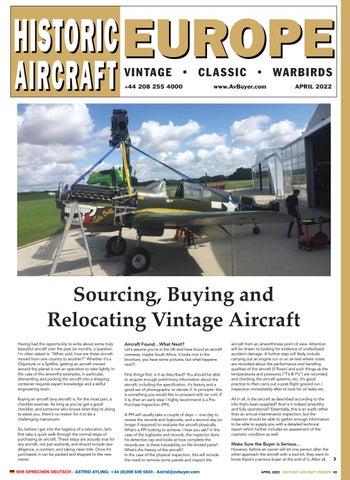Historic Aircraft.qxp_GAB Master LEFT 11/03/2022 16:12 Page 1
HISTORIC EUROPE AIRCRAFT
VINTA GE • CL A SSIC • WARBIRDS +44 208 255 4000
www.AvBuyer.com
APRIL 2022
Sourcing, Buying and Relocating Vintage Aircraft Having had the opportunity to write about some truly beautiful aircraft over the past six months, a question I’m often asked is: “When sold, how are these aircraft moved from one country to another?” Whether it’s a Chipmunk or a Spitfire, getting an aircraft moved around the planet is not an operation to take lightly. In the case of the airworthy examples, in particular, dismantling and packing the aircraft into a shipping container requires expert knowledge and a skilful engineering team. Buying an aircraft (any aircraft) is, for the most part, a checklist exercise. As long as you’ve got a good checklist, and someone who knows what they’re doing to assist you, there’s no reason for it to be a challenging manoeuvre. So, before I get into the logistics of a relocation, let’s first take a quick walk through the normal steps of purchasing an aircraft. These steps are actually true for any aircraft, not just warbirds, and should include due diligence, a contract, and taking clean title. Once it’s purchased, it can be packed and shipped to the new owner.
Aircraft Found…What Next?
Let’s assume you’re in the UK and have found an aircraft overseas, maybe South Africa. It looks nice in the brochure, you have some pictures, but what happens next?! First things first: is it as described? You should be able to acquire enough preliminary information about the aircraft, including the specification, it’s history and a good set of photographs, to decide if ‘in principle’ this is something you would like to proceed with (or not). If it is, then an early step I highly recommend is a PrePurchase Inspection (PPI). A PPI will usually take a couple of days — one day to review the records and logbooks, and a second day (or longer if required) to evaluate the aircraft physically. What’s a PPI looking to achieve, I hear you ask? In the case of the logbooks and records, the inspector dons his detective cap and looks at how complete the records are. Is there traceability on life-limited parts? What’s the history of the aircraft? In the case of the physical inspection, this will include the need to remove some panels and inspect the
WIR SPRECHEN DEUTSCH - ASTRID AYLING: +44 (0)208 549 5024 - Astrid@avbuyer.com
aircraft from an airworthiness point of view. Attention will be drawn to looking for evidence of undisclosed accident damage. A further step will likely include carrying out an engine run or an air-test where notes are recorded about the performance and handling qualities of the aircraft (if flown) and such things as the temperatures and pressures (“T’s & P’s”) are recorded, and checking the aircraft systems, etc. It’s good practice to then carry out a post-flight ground run / inspection immediately after to look for oil leaks etc. All in all, is the aircraft as described according to the info that’s been supplied? And is it indeed airworthy and fully operational? Essentially, this is an audit rather than an annual maintenance inspection, but the inspector should be able to gather enough information to be able to supply you with a detailed technical report which further includes an assessment of the cosmetic condition as well.
Make Sure the Buyer is Serious…
However, before an owner will let one person after the other approach the aircraft with a tool kit, they want to know there’s a serious buyer at the end of it. After all,
❯
APRIL 2022 HISTORIC AIRCRAFT EUROPE 49



